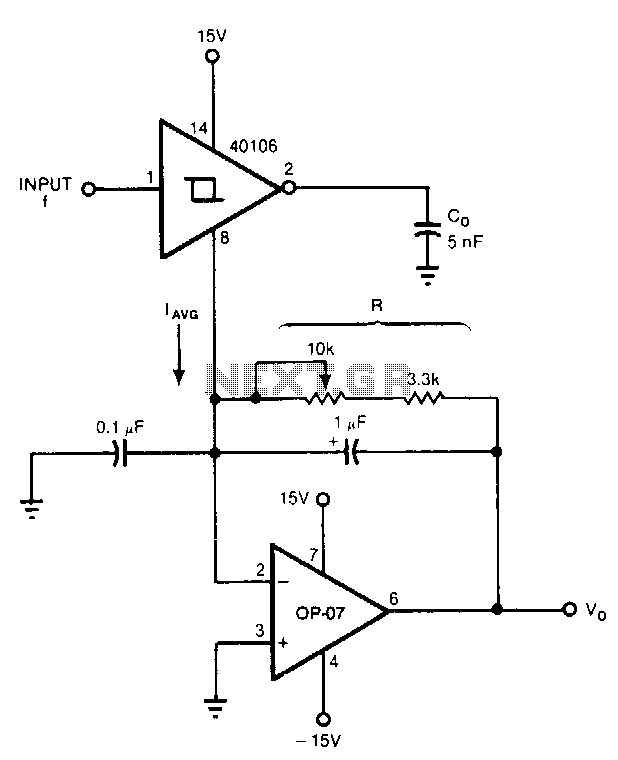
Frequency-to-voltage-converter

Six components can configure a circuit whose output voltage is proportional to its input frequency. The average current from the ground pin 8 of the 40106 Schmitt trigger inverter is linearly dependent on the frequency at which the capacitor is discharged into the op-amp's summing junction. The op-amp forces this current to flow through the 13.33 kΩ feedback resistor, producing a corresponding voltage drop. This frequency-to-voltage converter yields a 0 to -10 V output with input frequencies ranging from 0 to 10 kHz.
The described circuit functions as a frequency-to-voltage converter, utilizing six key components: a Schmitt trigger inverter, an operational amplifier (op-amp), a capacitor, and a feedback resistor. The circuit operates by taking an input frequency, which is applied to the Schmitt trigger inverter. This inverter generates a square wave output that corresponds to the input frequency. The average current produced by this square wave is then directed to the summing junction of the operational amplifier.
The capacitor discharges into the summing junction at a rate that is directly proportional to the frequency of the input signal. As the frequency increases, the discharge rate of the capacitor also increases, resulting in a higher average current flowing through the circuit. The op-amp is configured to convert this current into a voltage. By using a feedback resistor of 13.33 kΩ, the op-amp creates a voltage drop that corresponds to the average current, thereby producing an output voltage that is proportional to the input frequency.
The output voltage of this circuit ranges from 0 V to -10 V, effectively translating input frequencies from 0 Hz to 10 kHz into a linear voltage output. This characteristic makes the circuit suitable for applications where frequency measurement or conversion into a voltage signal is required, such as in signal processing, instrumentation, and control systems. The precision of the output voltage is highly dependent on the stability of the components used, particularly the op-amp and the feedback resistor. Proper selection and calibration of these components are essential to ensure accurate frequency-to-voltage conversion.Six components can configure a circuit whose output voltage is proportional to its input frequency. The average current (hvc from the 40106 Schmitt trigger inverter"s ground pin 8 is linearly dependent on the frequency at which CO is discharged into the op amp"s summing junction. The op amp forces this current to flow through the 13.33-Kfl feedback resistor, producing a corresponding voltage drop. This frequency-to-voltage converter yields 0 to -10 V output with 0 to 10kHz input frequencies. 🔗 External reference
The described circuit functions as a frequency-to-voltage converter, utilizing six key components: a Schmitt trigger inverter, an operational amplifier (op-amp), a capacitor, and a feedback resistor. The circuit operates by taking an input frequency, which is applied to the Schmitt trigger inverter. This inverter generates a square wave output that corresponds to the input frequency. The average current produced by this square wave is then directed to the summing junction of the operational amplifier.
The capacitor discharges into the summing junction at a rate that is directly proportional to the frequency of the input signal. As the frequency increases, the discharge rate of the capacitor also increases, resulting in a higher average current flowing through the circuit. The op-amp is configured to convert this current into a voltage. By using a feedback resistor of 13.33 kΩ, the op-amp creates a voltage drop that corresponds to the average current, thereby producing an output voltage that is proportional to the input frequency.
The output voltage of this circuit ranges from 0 V to -10 V, effectively translating input frequencies from 0 Hz to 10 kHz into a linear voltage output. This characteristic makes the circuit suitable for applications where frequency measurement or conversion into a voltage signal is required, such as in signal processing, instrumentation, and control systems. The precision of the output voltage is highly dependent on the stability of the components used, particularly the op-amp and the feedback resistor. Proper selection and calibration of these components are essential to ensure accurate frequency-to-voltage conversion.Six components can configure a circuit whose output voltage is proportional to its input frequency. The average current (hvc from the 40106 Schmitt trigger inverter"s ground pin 8 is linearly dependent on the frequency at which CO is discharged into the op amp"s summing junction. The op amp forces this current to flow through the 13.33-Kfl feedback resistor, producing a corresponding voltage drop. This frequency-to-voltage converter yields 0 to -10 V output with 0 to 10kHz input frequencies. 🔗 External reference
Warning: include(partials/cookie-banner.php): Failed to open stream: Permission denied in /var/www/html/nextgr/view-circuit.php on line 713
Warning: include(): Failed opening 'partials/cookie-banner.php' for inclusion (include_path='.:/usr/share/php') in /var/www/html/nextgr/view-circuit.php on line 713